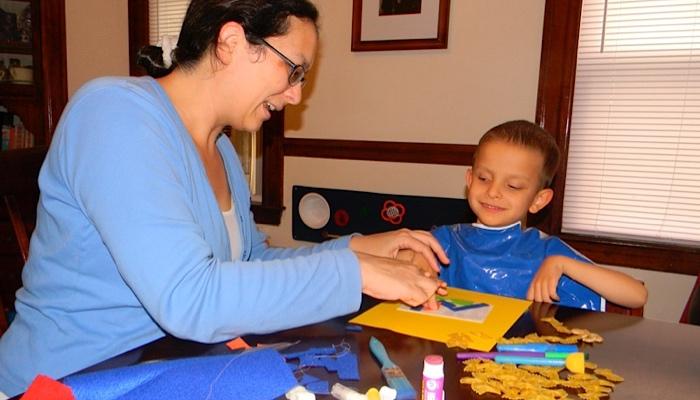Sensory Art for Children who are Visually Impaired

At first glance, art seems like a very visual medium. We appreciate art by looking at it, not touching it, right? Even tactile sculptures in museums are off limits to little exploratory fingers!
But there are so many different aspects to art and creativity that can benefit your child. It’s certainly worth exploring how to adapt traditional art projects and curriculum into sensory art.
It’s really not that hard to create a sensory art project. Most art easily moves beyond the visual: Craft projects almost always involve our hands and fingers as we touch the glue, paint, or other materials; sensory art will always have a very particular smell, whether that’s the pungent odor of rubber cement or the sweet scent of potpourri; and our art projects can make sounds as we craft wind chimes or bells.
The possibilities are endless! Check out our list of Sensory Art Projects for some fun ideas.
Art Tips
The best way to get your kids excited about art is to have fun! Here are a few tips to keep the atmosphere light and happy:
-
- Play it Safe: Make sure to only use non-toxic materials. Art supplies will end up in places they’re not supposed to be (like in the mouth or eyes) no matter how careful you are.
-
- Cover Up: Have your kids wear old clothes or a smock while creating their masterpieces. Cover the table with butcher’s paper or have them work on an old surface you don’t care about. If you’re constantly worried about drops and spills no one is going to have any fun.
-
- Bring On the Cookies: If your child is the sort to put everything in their mouth (like mine) it’s going to be difficult to convince them that paint brushes and glue really shouldn’t be tasted. I keep a box of small cookies (like Annie’s Bunny Grahams) on the table so Ivan can safely get his oral fix now and then.
-
- Get Creative: Think outside the box when it comes to art supplies. Try to find objects that have really interesting textures or scents. Herbs and spices (like cloves or cardamom pods) can replace macaroni in glue art projects; explore your fabric store’s remnant section for unusual specimens; raid your kitchen pantry for neat things your kids can paint or glue together that are safe to play with and feel or smell different.
-
- Back Off: Your child will probably need a lot of help finding the art supplies and putting things together, but try to back up once in a while and just let them explore. Art can be a great exploration motivator!
- Talk About It: As your child touches the felt, mention that it is soft; as they touch the glue, tell them that it is sticky. Give your child the words they need to describe all these things they are touching. This is a fun way to build your child’s tactual vocabulary!
Displaying Your Masterpieces
Once your child has created an array of wonderful art pieces, you’ll want to show them off to everyone you know! We usually put paintings behind glass when we want to showcase them, but for blind kids this just makes the art off limits.
I love framing Ivan’s work. It makes it easier to display and also shows Ivan just how important I think his art is. To do this I buy cheap black frames and pop the glass out. Ivan’s art can then sit in the frame (which he can feel), but the tactual aspect of the piece is preserved.
You can also use double-sided tape to adhere the art work to the front of the glass. The frame is still intact, but the art is in front of the glass rather than behind it.
Another option is to get a big bulletin board and tack your child’s art pieces to the board. It’s another way to let them know that you think their art is special. Plus it’s easy to update with new projects!
Read this article in Arabic: حيوا-السيدة-العمياء
Related Posts

Eye Conditions and Syndromes, Visual Impairment
Neuralink Announces Plans to Restore Sight to the Blind with Brain Chip
Elon Musk’s company Neuralink has announced plans to begin human trials of its new “Blindsight” brain chip by the end of 2025.

Visual Impairment
The Gift of Understanding: How a Young Child Helps His Blind Father Navigate Life
When a parent is blind, it’s natural for people to wonder how their sighted child will adapt. Will they struggle to understand their parent’s needs? Will they feel burdened by...

Braille and Literacy, Toys, Visual Impairment
24 Braille Toys for Kids Who are Blind
Everything from alphabet blocks to raised line coloring pages and activity books to puzzles to card and board games... and so much more! And it's all in braille ready for...